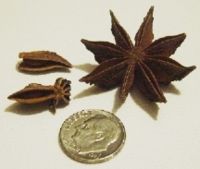Illicium
| subsp. var. | ||||||||||||||||||||||||||||||||||||||||||||||||||||||||
|---|---|---|---|---|---|---|---|---|---|---|---|---|---|---|---|---|---|---|---|---|---|---|---|---|---|---|---|---|---|---|---|---|---|---|---|---|---|---|---|---|---|---|---|---|---|---|---|---|---|---|---|---|---|---|---|---|

|
|
| ||||||||||||||||||||||||||||||||||||||||||||||||||||||
| ||||||||||||||||||||||||||||||||||||||||||||||||||||||||
| Standard Cyclopedia of Horticulture |
|---|
|
Illicium (Latin for allurement; probably in reference to the agreeable odor). Magnolidceae. Small trees or shrubs, one of which is sometimes planted far South. Aromatic glabrous plants, with thick short-petioled entire evergreen lvs.: fls. perfect, small, solitary or in 3's in the axils of lvs. or bud-scales, nodding or inclined, yellow or purplish; sepals 3-6; petals many, imbricated in 3 or more rows or series; stamens 10 to many, with thick filaments: carpels usually many, forming a ring of almost woody pods.—Species about a score, mostly oriental (India, China, Philippines), and 2 in the S. U. S. One of the illiciums furnishes the star or Chinese anise, which is the small star-shaped cluster of fruits. The odor and flavor strongly resemble anise. It is much used in oriental countries in cookery, and is exported to some extent and is said to be used in flavoring certain French wines. This product comes from China. It has been supposed to be the product of I. anisalum of Linnaeus, but that plant is a Japanese tree and it contains a poison. In the American trade are the names I. anisalum and I. religiosum. It now transpires that these names belong to the same plant, and that the star anise is produced by another species. This other species, or the true star anise, was first accurately described and figured (as I. verum, Hook, f.) in B.M. 7005 (1888), where the confusion of two or three centuries is elucidated. There is probably only one east Asian illicium in the trade in North America, as follows: Illicium anisatum, Linn. (I. religiosum, Sieb. & Zucc.). Small tree: lvs. alternate, elliptic, short-petioled, somewhat acuminate: fls. mostly solitary, sessile or nearly so, yellowish, not fragrant, with many very narrow petals, and 20-30 stamens. Japan. B.M. 3965.—Grown far S. About as hardy as camellia. There is a form with variegated lvs. Two native illiciums growing in the S. are: I. floridanum, Ellis. Shrub, 6-10 ft.: lvs. oblong-lanceolate, 4-in. or more long: petals 20-30, very narrow, dark crimson or purple. Fla. to La. B.M.439. Gn. 36, p. 151. J.H. III. 30: 365; 52: 168. H.U. 5, p. 136. — I. parviflorum, Michx. Lvs. elliptic or lanceolate, mostly under 4 in. long: petals very small (1/4 in. long), 6-12, yellowish: less tall. Ga. and Fla.—A species appearing in European horticultural literature in recent years is I. laurifolium, Hort. It is described as a handsome evergreen shrub: Ivs. short-stalked, oval, acute: fls. yellowish white, in many-fld. terminal cymes. Of uncertain origin. K.H. 1901, p. 17.—I. verum, Hook, f. The true star anise: 9 ft.: lvs. elliptic to oblanceolate: fls. red, globose, the petals about 10. China. L H. B.
|
This page is about the genus of plants. Illicium is also a term for the modified first dorsal fin ray of angler fishes, used to attract prey.
| Illicium {{{status}}} Fossil range: {{{fossil_range}}}
| ||||||||||||||||||||||||||||||||||||||||||||||||||||||||||||||||||
|---|---|---|---|---|---|---|---|---|---|---|---|---|---|---|---|---|---|---|---|---|---|---|---|---|---|---|---|---|---|---|---|---|---|---|---|---|---|---|---|---|---|---|---|---|---|---|---|---|---|---|---|---|---|---|---|---|---|---|---|---|---|---|---|---|---|---|
 Star anise fruits (Illicium verum) | ||||||||||||||||||||||||||||||||||||||||||||||||||||||||||||||||||
| Plant Info | ||||||||||||||||||||||||||||||||||||||||||||||||||||||||||||||||||
| ||||||||||||||||||||||||||||||||||||||||||||||||||||||||||||||||||
| Scientific classification | ||||||||||||||||||||||||||||||||||||||||||||||||||||||||||||||||||
| ||||||||||||||||||||||||||||||||||||||||||||||||||||||||||||||||||
| [[{{{diversity_link}}}|Diversity]] | ||||||||||||||||||||||||||||||||||||||||||||||||||||||||||||||||||
| {{{diversity}}} | ||||||||||||||||||||||||||||||||||||||||||||||||||||||||||||||||||
| Binomial name | ||||||||||||||||||||||||||||||||||||||||||||||||||||||||||||||||||
| {{{binomial}}} | ||||||||||||||||||||||||||||||||||||||||||||||||||||||||||||||||||
| Trinomial name | ||||||||||||||||||||||||||||||||||||||||||||||||||||||||||||||||||
| {{{trinomial}}} | ||||||||||||||||||||||||||||||||||||||||||||||||||||||||||||||||||
| Type Species | ||||||||||||||||||||||||||||||||||||||||||||||||||||||||||||||||||
| {{{type_species}}} | ||||||||||||||||||||||||||||||||||||||||||||||||||||||||||||||||||
| Species | ||||||||||||||||||||||||||||||||||||||||||||||||||||||||||||||||||
| 42 species; see article | ||||||||||||||||||||||||||||||||||||||||||||||||||||||||||||||||||
| [[Image:{{{range_map}}}|{{{range_map_width}}}|]] | ||||||||||||||||||||||||||||||||||||||||||||||||||||||||||||||||||
| Synonyms | ||||||||||||||||||||||||||||||||||||||||||||||||||||||||||||||||||
| {{{synonyms}}} |
Illicium (Anise-tree, Anise tree) is a genus of flowering plants containing 42 species of evergreen shrubs and small trees, and is the sole genus in family Illiciaceae. The species are native to the tropical and subtropical regions of eastern and southeastern Asia, southeastern North America, and the West Indies.
- Selected species
- Illicium anisatum (Japanese Star Anise). Southern Japan, Taiwan.
- Illicium arborescens. Taiwan.
- Illicium floridanum (Purple Anise or Florida Anise). Southeastern United States.
- Illicium henryi (Henry's Anise). Southwestern China.
- Illicium lanceolatum. Southern China.
- Illicium mexicanum (Mexican Anise). Mexico.
- Illicium parviflorum (Yellow Anise). Southeastern United States.
- Illicium ternstroemioides. Southern China.
- Illicium verum (Star Anise). Southern China, Vietnam.
Uses
The fruits of Illicium verum are known as star anise, and are used as a seasoning in Chinese and southeast-Asian cooking. Japanese star anise (Illicium anisatum) is used in Japan to produce incense, but its fruits are toxic if ingested.